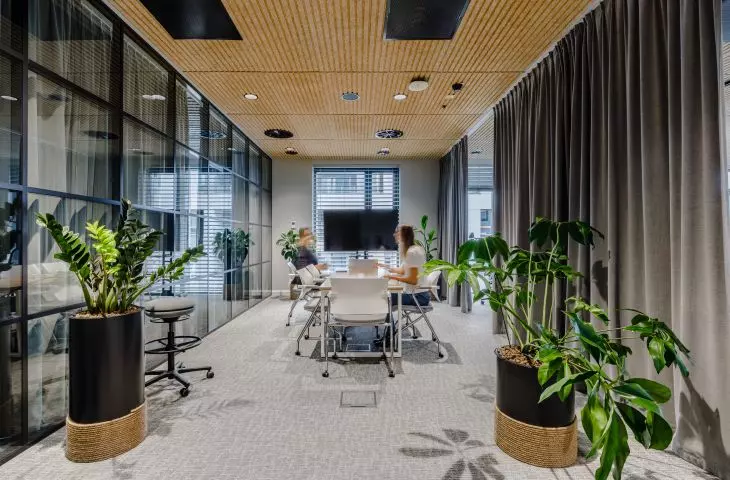Hygge is a Danish term for comfort and coziness. A perverse career began a few years ago, and the trend was reinforced by the period of the first lockdowns during the pandemic. We associate finding ourselves in this state primarily with ephemeral pleasure and its total devotion.
additional element is wood
photo by Adam Grzesik | © Workplace
Hygge is thus a certain lifestyle indicator of how we feel about ourselves usually resting. Are the conditions of potential coziness also possible when creating a work space? Creating an office in hygge style was undertaken by architects from Workplace studio, creating a place for Maersk employees in Gdynia. The office was to be employee-friendly, while at the same time using ecological elements.
Through discussions and joint strategy formulation, we agreed that the design of the office was to be based on three main assumptions: the least possible impact on the environment, the creation of a home-like atmosphere and the subtle inclusion of the Maersk brand. The proposed design was to be without extravagance, timeless and friendly in its aesthetics, and above all, based on a sustainable and less waste approach. - Ewa Jędras, Senior Architect Workplace, sums up the architect.
The office is divided into spaces for solitary as well as group work
photo by Adam Grzesik | © Workplace
dividing smaller and larger
The most common office layout of recent years has been the notorious open space, which created one large common area instead of cramped cubicles for employees. In this case it was different, which resulted from the combination of several offices from different locations, as well as different needs.
The architects decided on a layout composed of decentralized small work zones, which are separated by green screens, acoustic curtains or panels. In this way we can organize our work according to the task at hand - if we need peace and quiet, which we usually didn't find in open space, here it will be solved seamlessly. In addition, such a division increases acoustic comfort.
The same is true of places where we want to work in groups. The office is equipped with so-called focus rooms, creative work zones, as well as telephone booths that are indispensable and facilitate contact. If we want to work in conditions closer to home, we can find simple home-like armchairs or sofas, but also tables with adjustable top heights.
Greenery is an important design element
photo by Adam Grzesik | © Workplace
in grays and beiges
As far as the color scheme is concerned, two dominants have been decided upon - light grays and beiges in varying shades. They define practically all the office spaces. In many places they are broken by accessories in blue, which refers to the color scheme used in Maersk's corporate identity.
There is also a different color scheme in areas where focus on work is not required - warm shades of red, orange or yellow reign there. Then there is wood in various formulations - from floors, furniture to wooden laths used as screens. They can be found everywhere, as well as plants, which is supposed to complete the Hygge effect of the title.
The divisions in the office are delineated by greenery, screens and acoustic panels
photo by Adam Grzesik | © Workplace
looking for more valuable solutions
In addition to the division and color scheme, the architects wanted to use less waste materials, which not only reduced costs but also allowed some materials to be reused. Much of the furniture was commissioned from local artisans. Some furniture came from second-hand sources and was refurbished in cooperation with suppliers. Internal recycling - bringing in furniture from the company's previous locations - was also a formula to limit the use of raw materials. A sizable portion of the table tops were made from recycled plastic, from compressed plastic waste.
Blue appears alongside grays and beiges
photo by Adam Grzesik | © Workplace
looking for the optimal solution
Modern offices are characterized primarily by the need to change the formula of work. We are moving away from rigid frameworks to more active, fluid forms. Therefore, offices need to understand this trend and seek answers for them.
Employees are accompanied at every step by greenery
photo by Adam Grzesik | © Workplace

































